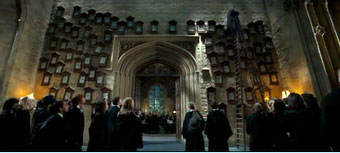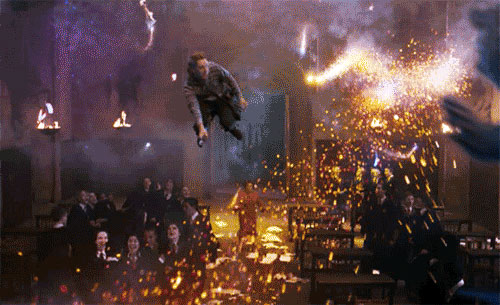In the Harry Potter films, every time we get to see Harry’s Muggle home in Little Whinging, we see the very tight order of the community.

We know that Harry is not happy here, but the nature of his treatment by his Aunt and Uncle could easily explain that. However, the film of Harry Potter and the Order of the Phoenix gives us many strong visuals for an underlying clash of Chaos and Order that runs throughout the Harry Potter series.
And the first hint of this clash is the oppressive conformity of the Muggle residential community.
Good Versus Evil
When writers want to show the clashing of forces – usually implying Good versus Evil – they often choose to set Order against Chaos. And in this conflict, Good usually puts on the garb of Order, while Evil dresses in Chaos. However, J.K. Rowling plays against this pattern and it shows most clearly in the film for The Order of the Phoenix.
Perhaps it would be a useful idea to back up a bit and consider what makes for “good.” Why are there some things we consider to be “good” and other things we consider “bad” or “evil”? Certainly, we believe that it is good to be healthy and bad to be ill. But we don’t usually think a sick person is therefore evil because something is wrong in their body. Usually. There certainly have been times in the past when that was not the case. And actually, even now, sometimes some people do wonder what you did wrong that caused you to have a particular ailment. This simple, biological factor is one of the main reasons why humans consider it “good” when our bodies are “in order.”
Order and Chaos
Because we also see things in a bilateral fashion – left and right, or as the Romans called them, “sinister” and “dexter” – we like to set up opposites. We are drawn to dualities of unlike things. So, because our health tells us that “order” is “good” for our bodies, we tend to classify all Order as always Good. And the opposite state, dis-order, is not good. And we see Chaos as disorder.
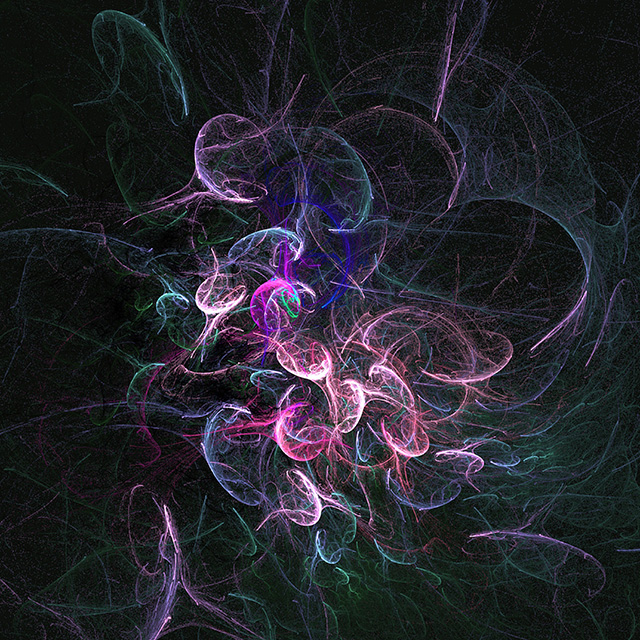
Now, in recent decades fractal mathematics has come to show us that even chaos has a type of order to it. But it is a less restrictive order; it is reactive to what it encounters and has a degree of self-organization rather than an externally imposed order.
But what does Chaos Theory have to do with Harry Potter and the Order of the Phoenix?
The Appeal of Chaos
Rowling uses the stories in the Harry Potter series to cast Good in a less restrictive role. The appeal of the Wizarding World takes us away from the constrictive order of Little Whinging and into the wonders of the magical realm.
Certainly, we are charmed by the disorderly conduct of those Agents of Chaos, the Weasley twins, Fred and George.
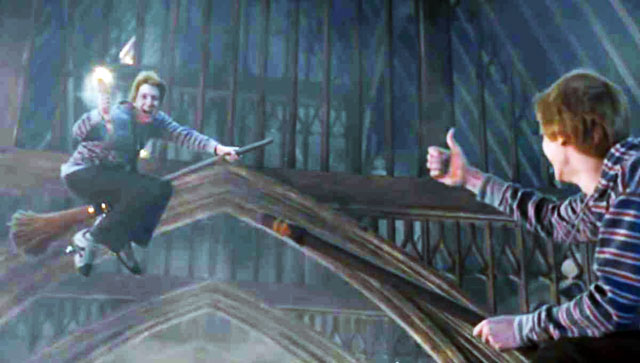
Visually, the films of the series show the Wizarding World as slightly skewed for the most part (the notable exceptions being the Ministry of Magic and Hogwarts’ seeming structural order).
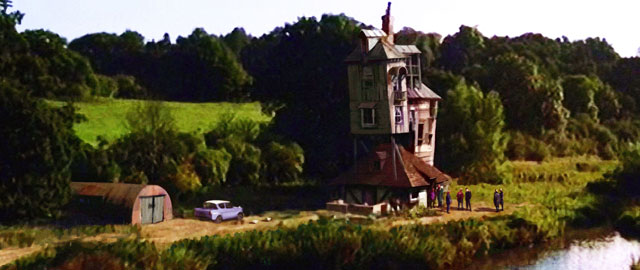
Lest anyone think the visuals of Order = Bad and Chaos = Good are the choice of the filmmakers, Rowling in the text of Harry Potter and the Chamber of Secrets gives this description of the Weasleys’ home, the Burrow.
It looked as though it had once been a large stone pigpen, but extra rooms had been added here and there until it was several stories high and so crooked it looked as though it were held up by magic (which, Harry reminded himself, it probably was). Four or five chimneys were perched on top of the red roof. A lopsided sign stuck in the ground near the entrance read, THE BURROW. Around the front door lay a jumble of rubber boots and a very rusty cauldron. Several fat brown chickens were pecking their way around the yard.
“It’s not much,” said Ron.
“It’s wonderful,” said Harry happily, thinking of Privet Drive.
(HPCoS: Chapter 3 “The Burrow”)
We should also note the irony of the name of the Weasley home: the Burrow. Burrows usually disappear into the ground, hidden from view. But the Weasley home rises up into the air and is highly visible, if one is a magical person looking for it.
The homey appeal of the Weasleys’ Burrow is immediately felt. For all the apparent disorder of the home, it is also highly expressive of the residents: Molly’s housekeeping and homemaking are seen in dishes being washed and yarn knitting itself; her concern for her family is manifested in her “clock” which shows where various members are (or aren’t); Arthur’s various tinkerings with Muggle artifacts linger in the background. All this is in high contrast to the bland social conformity of the Dursley household.
The Unappeal of Order
In the film of The Order of the Phoenix, Umbridge’s office presents a visual attempt at ‘coziness,” what with the pink and kittens that abound. But it is all over-done, for she has even tinted the castle walls of her office with the color pink. Her requirement of order before all is displayed when she even straightens the pencils on her desk before Harry enters.
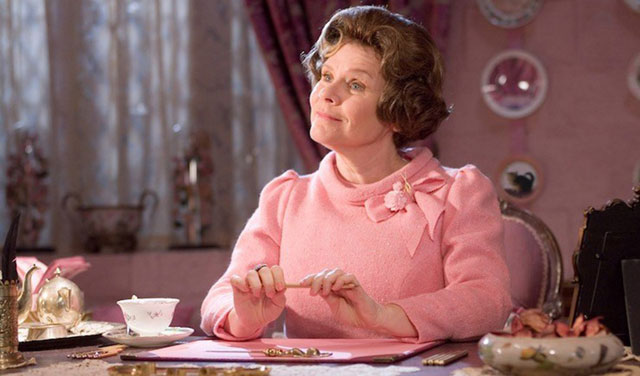
Umbridge sets out to impose order on the chaos she perceives at Hogwarts. Her nearly endless rules and regulations clutter the wall holding the entrance to the castle’s Great Hall. Her restrictions are attempts to control almost every expression of individuality from the students, from slight disorders in how they dress to how the students interact (especially public displays of affection between boys and girls) to even practicing magical skills (whether charming paper birds, playing ball games with sparkling fireballs, or even simple wand “swishing”).
The treatment of Order being a manifestation of the “Dark Side” shows up later in the series, after Dumbledore’s death. When Snape becomes Headmaster, his regimented control of the students is shown on film as the students march in complete lockstep. The regimentation chosen by Umbridge and Snape keeps the students separate from each other while also stifling individuality.
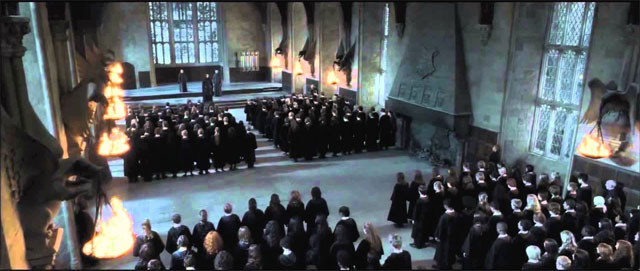
When the Weasley twins choose to abandon schooling under Umbridge, their departure becomes a joyous celebration in the midst of her stifling atmosphere of Order. They disrupt the O.W.L. Testing, setting off fireworks (including a magnificent dragon head), and blasting down the displayed regulations Umbridge has enacted.
The Benefits of Chaos
J.K. Rowling’s reversal of the preference of Order and Chaos has provoked questions about “What kind of school is this?” Students – children – are given dangerous tasks; they (at least Harry and his companions) are allowed to break rules to a certain degree. Surely this is not an ideal model for “Real World” schools. But the point of the Harry Potter series is that in the fight against an evil, and especially one like that in these books, it is often the unexpected — almost chaotic — choices and turns that make the difference in the conflict.
As noted earlier in the comments about fractal mathematics, there is a degree of self-organization involved, rather than compliance to an externally imposed order. In The Order of the Phoenix, we see this as Dumbledore’s Army comes together. For their private Defense Against the Dark Arts class, the students self-select and self-organize. They are exemplars of Chaos Theory as the group is made of students from several different years and three different Hogwarts Houses.
To wrap up the whole point of displaying the “good” of Chaos over Order in this series, consider the choices that Dumbledore makes as he tries to prepare Harry for his eventual last confrontation with Voldemort. Dumbledore does not give Harry explicit instructions for finding and destroying the horcruxes. He was giving Harry freedom in finding solutions, trusting Harry’s imagination rather than restricting Harry with instructions. After all, instructions are rules that are limitations. Harry will have to go beyond limitations – even the limitations of death – in order to defeat Voldemort. Which answers Ron’s distressed question about why Harry doesn’t know more about finding and destroying the horcruxes. Knowing would have limited and hindered Harry.


